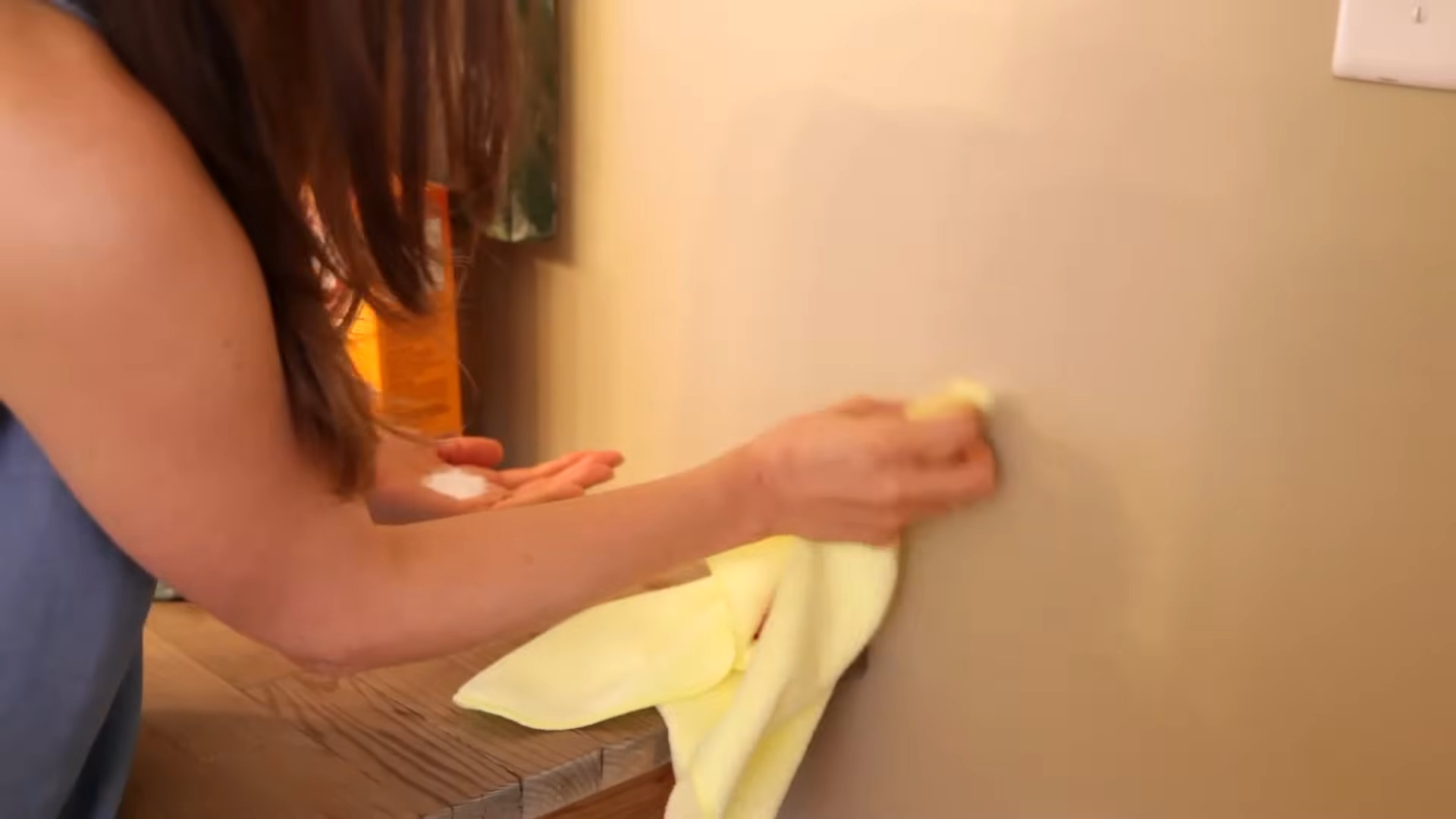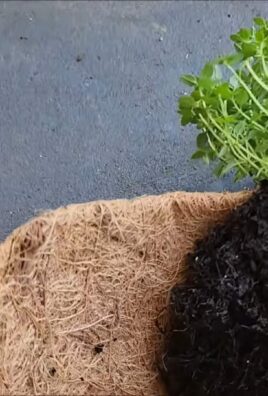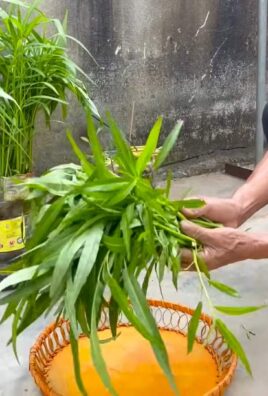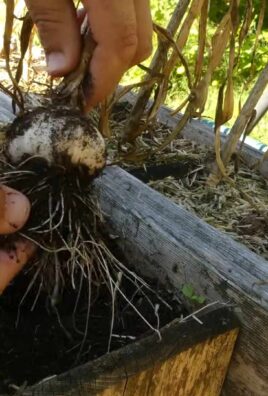Grow Asparagus at Home? Absolutely! Imagine stepping into your backyard and harvesting fresh, tender asparagus spears, ready to be steamed, grilled, or tossed into a vibrant spring salad. Forget those bland, expensive stalks from the grocery store – with a little know-how, you can cultivate your own asparagus patch and enjoy this delectable vegetable for years to come.
Asparagus has a rich history, dating back to ancient Greece and Rome, where it was prized for its medicinal properties and culinary delights. Emperors and commoners alike savored its unique flavor. Today, this perennial vegetable remains a springtime favorite, but many are intimidated by the thought of growing it themselves. That’s where this DIY guide comes in!
I understand that starting a garden can feel overwhelming, but trust me, growing asparagus at home is more accessible than you might think. This article will break down the process into simple, manageable steps, offering practical tips and tricks to ensure your success. We’ll cover everything from selecting the right variety and preparing your soil to planting, watering, and harvesting your delicious crop. Why spend money on store-bought asparagus when you can have a thriving patch right outside your door? Let’s get started and unlock the secrets to successfully grow asparagus at home!

Growing Asparagus: A Beginner’s Guide to a Delicious Harvest
Asparagus! Just the word conjures up images of spring, fresh flavors, and maybe even a fancy dinner. But guess what? You don’t need a sprawling farm to enjoy homegrown asparagus. I’m going to walk you through how to grow your own asparagus patch, even if you’re a complete beginner. It takes patience, but trust me, the reward of snapping off those tender spears you grew yourself is totally worth it.
Choosing Your Asparagus Variety
First things first, let’s talk about asparagus varieties. This isn’t like picking out a tomato at the grocery store; asparagus is a long-term commitment, so choose wisely!
* ‘Jersey Knight’: This is a popular choice for a reason. It’s an all-male hybrid, which means it produces more spears and fewer seeds (seeds take energy away from spear production). It’s also disease-resistant and yields well. I highly recommend this one for beginners.
* ‘Jersey Giant’: Similar to ‘Jersey Knight,’ but slightly larger spears. Another excellent choice for high yields and disease resistance.
* ‘Purple Passion’: If you want something a little different, ‘Purple Passion’ offers beautiful purple spears that turn green when cooked. It’s sweeter than green varieties and adds a pop of color to your garden.
* ‘Mary Washington’: An older heirloom variety. It’s reliable but can be more susceptible to disease than the Jersey hybrids.
My Recommendation: If you’re just starting out, go with ‘Jersey Knight’ or ‘Jersey Giant.’ They’re reliable, productive, and relatively easy to grow.
Preparing Your Asparagus Bed: Location, Location, Location!
Asparagus is a perennial, meaning it will come back year after year. So, picking the right spot is crucial. Think of it as choosing the perfect location for a long-term tenant in your garden.
* Sunlight: Asparagus needs at least 6-8 hours of direct sunlight per day. The more sun, the better the spear production.
* Soil: Well-drained soil is essential. Asparagus crowns will rot if they sit in soggy soil. Aim for a sandy loam soil that’s rich in organic matter.
* Space: Asparagus plants can get quite large (3-5 feet tall and wide), so give them plenty of room to spread out. A dedicated asparagus bed is ideal.
* Avoid Shady Areas: Don’t plant near trees or shrubs that will compete for sunlight and nutrients.
Step-by-Step Planting Guide
Okay, now for the fun part: getting those asparagus crowns in the ground!
1. Soil Preparation: This is the most important step! Asparagus needs a deep, well-prepared bed.
* Dig a trench that is 12-18 inches wide and 6-8 inches deep. The length will depend on how many crowns you’re planting.
* Amend the soil with plenty of compost, well-rotted manure, or other organic matter. Asparagus is a heavy feeder, so give it a good start. I usually add a generous amount of compost and some bone meal for phosphorus.
* Mix the amendments thoroughly into the soil at the bottom of the trench.
2. Planting the Crowns:
* Space the asparagus crowns about 12-18 inches apart in the trench.
* Create small mounds of soil in the trench, and place each crown on top of a mound. The crown should be positioned so the buds (the little pointy things) are facing upwards.
* Gently spread the roots out around the mound.
* Cover the crowns with about 2-3 inches of soil.
3. Watering:
* Water the newly planted crowns thoroughly.
* Keep the soil consistently moist, but not soggy, during the first growing season.
4. Filling the Trench:
* As the asparagus spears emerge and grow, gradually fill in the trench with soil.
* Continue to add soil until the trench is completely filled in. This process encourages the crowns to develop a strong root system.
5. Mulching:
* Apply a layer of mulch around the asparagus plants to help retain moisture, suppress weeds, and regulate soil temperature. I like to use straw, wood chips, or shredded leaves.
Caring for Your Asparagus Patch: The Long Game
Asparagus requires patience. You won’t be harvesting spears in the first year. It takes time for the plants to establish a strong root system.
* Watering: Water regularly, especially during dry periods. Asparagus needs consistent moisture to thrive.
* Weeding: Keep the asparagus bed free of weeds. Weeds compete for nutrients and can harbor pests and diseases. Hand-weeding is best to avoid damaging the asparagus plants.
* Fertilizing: Fertilize your asparagus patch in early spring with a balanced fertilizer or compost. Asparagus is a heavy feeder, so regular fertilization is important for good spear production. I use a 10-10-10 fertilizer, following the instructions on the package.
* Cutting Back Ferns: In the fall, after the ferns have turned brown, cut them back to the ground. This helps to prevent disease and allows the plants to rest during the winter.
* Pest and Disease Control: Keep an eye out for common asparagus pests and diseases, such as asparagus beetles and rust. Treat any problems promptly with appropriate organic or chemical controls.
Harvesting Your Asparagus: Patience is a Virtue
This is where the patience really comes in!
* Year 1: Do NOT harvest any spears in the first year. Let the plants grow and develop a strong root system.
Asparagus! Just the word conjures up images of spring, fresh flavors, and maybe even a fancy dinner. But guess what? You don’t need a sprawling farm to enjoy homegrown asparagus. I’m going to walk you through how to grow your own asparagus patch, even if you’re a complete beginner. It takes patience, but trust me, the reward of snapping off those tender spears you grew yourself is totally worth it.
Choosing Your Asparagus Variety
First things first, let’s talk about asparagus varieties. This isn’t like picking out a tomato at the grocery store; asparagus is a long-term commitment, so choose wisely!
* ‘Jersey Knight’: This is a popular choice for a reason. It’s an all-male hybrid, which means it produces more spears and fewer seeds (seeds take energy away from spear production). It’s also disease-resistant and yields well. I highly recommend this one for beginners.
* ‘Jersey Giant’: Similar to ‘Jersey Knight,’ but slightly larger spears. Another excellent choice for high yields and disease resistance.
* ‘Purple Passion’: If you want something a little different, ‘Purple Passion’ offers beautiful purple spears that turn green when cooked. It’s sweeter than green varieties and adds a pop of color to your garden.
* ‘Mary Washington’: An older heirloom variety. It’s reliable but can be more susceptible to disease than the Jersey hybrids.
My Recommendation: If you’re just starting out, go with ‘Jersey Knight’ or ‘Jersey Giant.’ They’re reliable, productive, and relatively easy to grow.
Preparing Your Asparagus Bed: Location, Location, Location!
Asparagus is a perennial, meaning it will come back year after year. So, picking the right spot is crucial. Think of it as choosing the perfect location for a long-term tenant in your garden.
* Sunlight: Asparagus needs at least 6-8 hours of direct sunlight per day. The more sun, the better the spear production.
* Soil: Well-drained soil is essential. Asparagus crowns will rot if they sit in soggy soil. Aim for a sandy loam soil that’s rich in organic matter.
* Space: Asparagus plants can get quite large (3-5 feet tall and wide), so give them plenty of room to spread out. A dedicated asparagus bed is ideal.
* Avoid Shady Areas: Don’t plant near trees or shrubs that will compete for sunlight and nutrients.
Step-by-Step Planting Guide
Okay, now for the fun part: getting those asparagus crowns in the ground!
1. Soil Preparation: This is the most important step! Asparagus needs a deep, well-prepared bed.
* Dig a trench that is 12-18 inches wide and 6-8 inches deep. The length will depend on how many crowns you’re planting.
* Amend the soil with plenty of compost, well-rotted manure, or other organic matter. Asparagus is a heavy feeder, so give it a good start. I usually add a generous amount of compost and some bone meal for phosphorus.
* Mix the amendments thoroughly into the soil at the bottom of the trench.
2. Planting the Crowns:
* Space the asparagus crowns about 12-18 inches apart in the trench.
* Create small mounds of soil in the trench, and place each crown on top of a mound. The crown should be positioned so the buds (the little pointy things) are facing upwards.
* Gently spread the roots out around the mound.
* Cover the crowns with about 2-3 inches of soil.
3. Watering:
* Water the newly planted crowns thoroughly.
* Keep the soil consistently moist, but not soggy, during the first growing season.
4. Filling the Trench:
* As the asparagus spears emerge and grow, gradually fill in the trench with soil.
* Continue to add soil until the trench is completely filled in. This process encourages the crowns to develop a strong root system.
5. Mulching:
* Apply a layer of mulch around the asparagus plants to help retain moisture, suppress weeds, and regulate soil temperature. I like to use straw, wood chips, or shredded leaves.
Caring for Your Asparagus Patch: The Long Game
Asparagus requires patience. You won’t be harvesting spears in the first year. It takes time for the plants to establish a strong root system.
* Watering: Water regularly, especially during dry periods. Asparagus needs consistent moisture to thrive.
* Weeding: Keep the asparagus bed free of weeds. Weeds compete for nutrients and can harbor pests and diseases. Hand-weeding is best to avoid damaging the asparagus plants.
* Fertilizing: Fertilize your asparagus patch in early spring with a balanced fertilizer or compost. Asparagus is a heavy feeder, so regular fertilization is important for good spear production. I use a 10-10-10 fertilizer, following the instructions on the package.
* Cutting Back Ferns: In the fall, after the ferns have turned brown, cut them back to the ground. This helps to prevent disease and allows the plants to rest during the winter.
* Pest and Disease Control: Keep an eye out for common asparagus pests and diseases, such as asparagus beetles and rust. Treat any problems promptly with appropriate organic or chemical controls.
Harvesting Your Asparagus: Patience is a Virtue
This is where the patience really comes in!
* Year 1: Do NOT harvest any spears in the first year. Let the plants grow and develop a strong root system.
* Year 2: You can harvest a few spears for a very short period (about 2 weeks). This allows the plants to continue to mature.
* Year 3 and Beyond: Now you can start harvesting asparagus more regularly. Harvest spears when they are about 6-8 inches tall and about as thick as your finger.
* Harvesting Technique: Snap off the spears at ground level. You can use a knife, but snapping them is usually easier and less likely to damage the crown.
* Harvesting Period: The harvesting period typically lasts for 6-8 weeks in the spring. As the weather warms up, the spear production will slow down.
* Letting it Fern: Once the harvesting period is over, let the remaining spears grow into ferns. These ferns will provide the plants with the energy they need to produce spears next year.
Troubleshooting Common Asparagus Problems
Even with the best care, you might encounter some problems. Here are a few common issues and how to deal with them:
* Thin Spears: Thin spears can be a sign of nutrient deficiency, lack of water, or overcrowding. Fertilize regularly, water deeply, and thin out the plants if necessary.
* Yellowing Ferns: Yellowing ferns can be caused by disease, pests, or poor drainage. Check for pests and diseases, improve drainage, and fertilize if needed.
* Asparagus Beetles: These little beetles can damage the spears and ferns. Hand-pick them off the plants or use an organic insecticide.
* Rust: Rust is a fungal disease that can cause orange spots on the ferns. Improve air circulation, avoid overhead watering, and use a fungicide if necessary.
Enjoying Your Homegrown Asparagus
After all that hard work, it’s time to enjoy the fruits (or rather, vegetables) of your labor! Freshly harvested asparagus is incredibly delicious. Here are a few of my favorite ways to prepare it:
* Roasted: Toss asparagus spears with olive oil, salt, and pepper, and roast them in a 400°F oven for 10-15 minutes.
* Grilled: Grill asparagus spears over medium heat for 5-7 minutes, turning occasionally.
* Steamed: Steam asparagus spears for 5-7 minutes, until tender-crisp.
* Sautéed: Sauté asparagus spears in a pan with olive oil, garlic, and lemon juice.
* In Salads: Add raw or cooked asparagus to salads for a fresh, spring flavor.
Growing asparagus takes time and effort, but it’s a rewarding experience. With a little patience and care, you can enjoy fresh, homegrown asparagus for many years to come. Happy gardening!

Conclusion
So, there you have it! Growing asparagus at home isn’t just a gardening project; it’s an investment in years of delicious, fresh harvests. Forget those limp, overpriced spears from the grocery store. Imagine stepping out into your backyard and snipping vibrant, tender asparagus, bursting with flavor, ready to be transformed into a delectable side dish, a creamy soup, or a star ingredient in your favorite spring frittata.
This DIY approach to cultivating asparagus offers a unique level of control over the growing process. You can ensure your plants receive the best possible care, from selecting the perfect soil composition to providing optimal watering and fertilization. You’ll know exactly what’s going into your food, free from the pesticides and herbicides that can sometimes plague commercially grown produce. Plus, there’s an undeniable satisfaction in nurturing something from a tiny crown to a thriving, productive plant.
But the benefits extend beyond just taste and control. Growing your own asparagus is also a sustainable choice. You’re reducing your carbon footprint by eliminating the transportation and packaging associated with store-bought asparagus. You’re also contributing to a healthier ecosystem by creating a haven for beneficial insects and pollinators in your garden.
Ready to take your asparagus game to the next level? Consider experimenting with different varieties. ‘Jersey Knight’ is a popular choice for its high yields and disease resistance, while ‘Purple Passion’ offers a unique color and slightly sweeter flavor. You can also try companion planting. Tomatoes, basil, and parsley are all excellent companions for asparagus, helping to deter pests and improve growth.
Don’t be intimidated by the initial investment of time and effort. Remember, asparagus is a perennial plant, meaning it will come back year after year, providing you with a bountiful harvest for decades to come. Think of it as planting a legacy, a gift to yourself and future generations.
We’re confident that once you taste the difference between homegrown asparagus and the store-bought variety, you’ll be hooked. It’s a culinary experience that’s simply unmatched. So, grab your gardening gloves, prepare your soil, and get ready to embark on this rewarding journey.
We’re eager to hear about your experiences! Share your tips, tricks, and triumphs in the comments below. Let us know what varieties you’re growing, what challenges you’ve faced, and what delicious dishes you’ve created with your homegrown asparagus. Together, we can build a community of passionate asparagus growers and inspire others to embrace the joys of homegrown food. Don’t forget to use the hashtag #HomegrownAsparagus when sharing your photos and stories on social media! Let’s spread the word about the incredible benefits of growing your own asparagus at home.
Frequently Asked Questions (FAQ)
What is the best time of year to plant asparagus crowns?
The ideal time to plant asparagus crowns is in early spring, typically a few weeks before the last expected frost. This allows the crowns to establish themselves before the heat of summer arrives. In warmer climates, you can also plant in the fall, giving the crowns a head start before winter dormancy. Check your local gardening resources for specific planting dates in your region.
How long does it take for asparagus to produce a harvestable crop?
Patience is key when growing asparagus! It typically takes two to three years from planting crowns to harvest your first spears. In the first year, allow the plants to establish a strong root system. In the second year, you can harvest a very small amount, but it’s best to wait until the third year for a more substantial harvest. This waiting period ensures the plants have enough energy to produce a bountiful crop for years to come.
What type of soil is best for growing asparagus?
Asparagus thrives in well-drained, sandy loam soil with a pH between 6.5 and 7.5. The soil should be rich in organic matter. Before planting, amend the soil with compost or well-rotted manure to improve drainage and fertility. Avoid heavy clay soils, as they can become waterlogged and lead to root rot. If you have clay soil, consider planting asparagus in raised beds to improve drainage.
How much sunlight does asparagus need?
Asparagus requires at least six to eight hours of direct sunlight per day to thrive. Choose a planting location that receives full sun throughout the growing season. Insufficient sunlight can result in weak, spindly spears and reduced yields.
How often should I water asparagus?
Asparagus needs consistent moisture, especially during the growing season. Water deeply and regularly, especially during dry periods. Avoid overwatering, as this can lead to root rot. A good rule of thumb is to water when the top inch of soil feels dry to the touch. Mulching around the plants can help retain moisture and suppress weeds.
What are some common asparagus pests and diseases?
Asparagus beetles are a common pest that can damage the spears and foliage. Handpicking the beetles or using insecticidal soap can help control infestations. Asparagus rust is a fungal disease that can cause orange pustules on the stems and foliage. Ensure good air circulation around the plants and avoid overhead watering to prevent rust. If rust occurs, remove and destroy infected foliage. Fusarium wilt is another disease that can affect asparagus, causing yellowing and wilting of the plants. Choose disease-resistant varieties and practice crop rotation to prevent Fusarium wilt.
How do I harvest asparagus?
Harvest asparagus spears when they are about 6-8 inches tall and about as thick as your finger. Use a sharp knife to cut the spears at ground level. Avoid damaging the surrounding crowns. Harvest spears regularly throughout the harvest season, which typically lasts for 6-8 weeks in the spring. Stop harvesting when the spears become thin and spindly, as this indicates that the plants need to replenish their energy reserves.
Can I grow asparagus in containers?
Yes, you can grow asparagus in containers, but it requires a large container (at least 18 inches in diameter and depth) and well-draining potting mix. Choose a sunny location for your container-grown asparagus. Container-grown asparagus may require more frequent watering and fertilization than asparagus grown in the ground.
How do I fertilize asparagus?
Fertilize asparagus in early spring before the spears emerge and again after the harvest season. Use a balanced fertilizer or compost tea. Avoid over-fertilizing, as this can lead to excessive foliage growth at the expense of spear production.
How do I prepare asparagus for winter?
In the fall, after the foliage has turned yellow and died back, cut the ferns down to the ground. Remove any debris from around the plants to prevent disease. Apply a layer of mulch to protect the crowns from freezing temperatures. In colder climates, you may need to provide additional winter protection, such as covering the plants with straw or burlap.




Leave a Comment